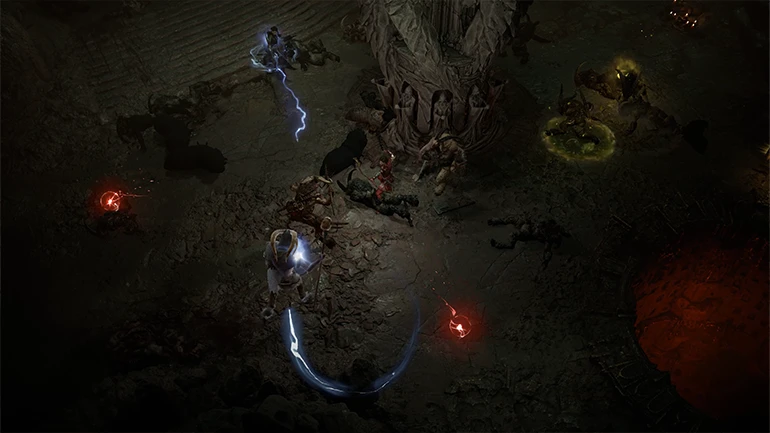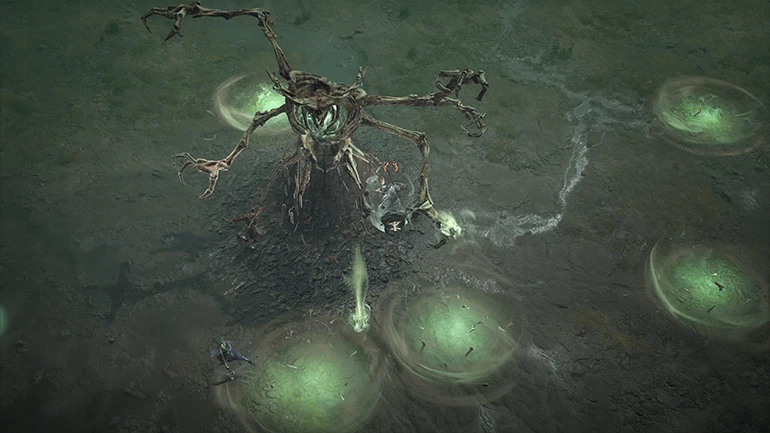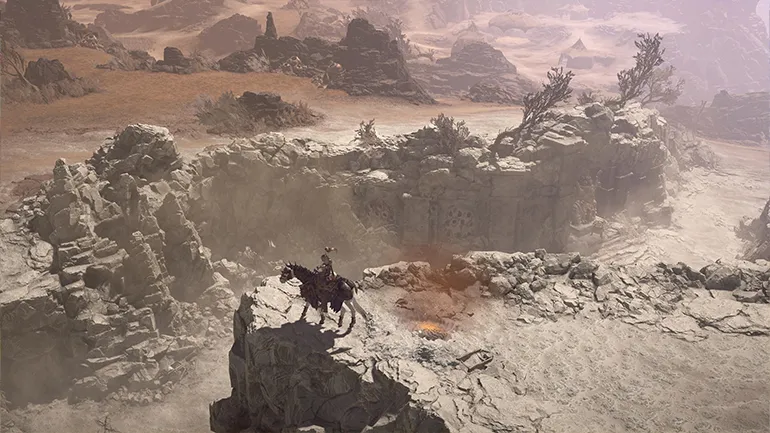Prepare to descend into darkness and embark on an unforgettable journey through Sanctuary in Diablo IV, the latest iconic isometric action RPG series installment. Like a symphony of chaos, this game weaves together layers of intricate gameplay systems, setting the stage for an exceptional experience that captivates and challenges.
In this unholy orchestra of bloodshed and loot, Diablo IV introduces a darker, more brooding atmosphere, departing from the vibrant exuberance of its predecessor, Diablo III. As you step into the shoes of a battle-worn hero, be prepared for a grim and unforgiving world where gruff-talking warriors shoulder the weight of Sanctuary's salvation. Yet, amidst this somber ambiance, Diablo IV shines with its central pillar—the unparalleled dungeon-crawling combat and loot collection that defines the series.
With sword in hand and spells at the ready, you'll engage in adrenaline-fueled battles against hordes of demonic monstrosities. The combat mechanics in Diablo IV are nothing short of a virtuoso performance, offering a symphony of direct attacks, devastating special abilities, and strategic passives that allow for endless customization. Craft your hero's build, hone your skills, and unleash destruction upon your foes as you traverse hauntingly beautiful landscapes that witness the world's imminent demise.
However, as any grand composition can occasionally lose its tempo, Diablo IV faces minor discordance in its execution. The intricate web of overlapping systems and mechanics threatens to drown out the exceptional gameplay experience it offers. Navigating through this labyrinth of complexity can be overwhelming, particularly for those new to the series. But fear not, for once you embrace the symphony of Diablo IV, the brilliance of its core gameplay pierces through, captivating even the most ardent critics.
In this review, we shall delve into the various facets of Diablo IV's dark opus. From the captivating combat that forms the heart of the game to the visual design that sets the stage for its grim narrative, we will explore the highs and lows, seeking harmony within. Brace yourself, adventurer, as we journey together into the treacherous realm of Diablo IV, where salvation and sacrifice intermingle, and the fate of Sanctuary hangs in the balance.

Gameplay: Unrivalled Dungeon-Crawling Combat
At the heart of Diablo IV lies a gameplay experience that sets the standard for dungeon-crawling combat and loot collection in the action RPG genre. You are immersed in a thrilling and visceral dance of blood and steel when you unsheathe your weapon and step into the depths of demonic-infested catacombs.
The combat in Diablo IV is a true symphony of destruction, combining the fluidity of direct attacks, the devastating impact of special abilities, the strategic depth of passive skills, and the awe-inspiring power of ultimate abilities. With a wide array of classes, each offering its unique playstyle, the combat never grows stale. Whether you prefer to rain down fiery meteors upon your enemies as a sorcerer or engage in lightning-fast strikes as a rogue, Diablo IV provides a diverse arsenal of skills to suit your preferred style of devastation.
One of the greatest joys of Diablo IV is the boundless freedom it grants in crafting and customizing your character build. Experimenting with different combinations of skills and passives opens up a world of possibilities, allowing you to fine-tune your hero to your liking. Adapt your playstyle to overcome the challenges before you, strategizing and adapting on the fly as you face ever more formidable adversaries.
The loot system in Diablo IV is a constant allure, drawing you deeper into the game's addictive loop. Each fallen foe presents an opportunity to acquire powerful weapons, armor, and trinkets that enhance your abilities and augment your combat prowess. The thrill of finding a rare and coveted item, be it a legendary weapon or a set piece that completes your build, is unparalleled. The loot game in Diablo IV is a never-ending pursuit of power, driving you to conquer ever more challenging dungeons and seek out the next upgrade to bolster your might.
The potential for endless hours of gameplay is one of Diablo IV's greatest strengths. The combination of addictive combat mechanics and the constant drive to acquire better gear makes each play session feel like a stepping stone toward becoming an unstoppable force. As you progress through the game, unlocking new skills and facing increasingly formidable adversaries, the sense of growth and accomplishment is immensely satisfying.
While Diablo IV's combat and loot systems stand unrivaled, it is worth noting that these aspects often overshadow other game elements. The sheer depth and complexity of the combat mechanics may be daunting for newcomers, and the focus on combat sometimes diminishes the attention given to other aspects, such as exploration and story progression. However, for those seeking a gameplay experience centered around thrilling dungeon-crawling combat and a never-ending pursuit of power, Diablo IV delivers in spades.

Visual Aesthetics: Departure from Diablo III
Diablo IV marks a significant departure in visual aesthetics from the vibrant and over-the-top style of its predecessor, Diablo III. The game takes a darker and more grounded approach, immersing players in a world that embraces a somber tone.
The shift in visual style has a profound impact on the overall atmosphere of Diablo IV. The game's environments are shrouded in darkness and desolation, creating an eerie and foreboding ambiance that resonates with the impending doom-threatening Sanctuary. The visual design effectively captures the grim and perilous nature of the world, setting the stage for the epic struggle against evil forces.
While the serious tone adds a sense of gravitas to the game's narrative and setting, it also has potential drawbacks. With its vibrant colors and fantastical visuals, Diablo III balanced darkness and lightheartedness. The juxtaposition of intense combat and whimsical elements added charm and entertainment to the experience. In Diablo IV, the absence of these playful and colorful elements can make the game feel more somber and monotonous, lacking the dynamic range that Diablo III showcased.
Despite this shift, Diablo IV does feature visually impressive environments. From the hauntingly beautiful snowy mountains to the desolate deserts and treacherous swamps, the world of Sanctuary is brought to life with meticulous attention to detail. The atmospheric lighting, intricate textures, and intricate level design create a visually stunning experience. However, one notable aspect that falls short is the lack of distinctiveness and variety between these regions. While each area may possess its unique visual flair, the differences can feel subtle, resulting in a sense of sameness as players traverse the vast open world.
Class Balance and Difficulty
One area where Diablo IV falls short is in the realm of class balance and difficulty. Throughout my time with the game, I had the opportunity to play in both the Rogue and Barbarian classes, and unfortunately, neither of them felt particularly well-balanced.
Regardless of the build I tried, I never felt like I was in control of a powerful warrior. Instead, I often found myself barely scraping by, struggling to survive encounters that felt genuinely impossible with the character I had chosen. It was only when I joined forces with other players that Diablo IV started to feel more manageable, but even then, it swung to the other extreme, becoming disappointingly easy.
This inconsistency in difficulty is especially evident in the encounters with dungeon bosses. Some of these encounters can be a cakewalk, where I effortlessly stormed in, decimated the boss, and teleported out. However, there were instances, such as my encounter with the Broodguard during the beta, where the difficulty spike felt frustratingly punishing, particularly for melee characters. Even with prior knowledge and an adjusted strategy, the fight still felt painfully unfair.
This lack of balance and difficulty spikes are recurring issues throughout Diablo IV. Some bosses feel nigh on impossible until you completely overhaul your character build. Balancing a game with as many complex systems as Diablo IV must be an incredibly daunting task, but at this stage, it's clear that Blizzard still has some work to do.
While I have yet to explore the other three classes, my experiences with the Barbarian and Rogue highlight the need to improve class balance and fine-tuning. Each class must offer a satisfying and balanced gameplay experience, ensuring players can find their preferred playstyle without encountering frustrating roadblocks or feeling overpowered.

Open World: Pros and Cons
Diablo IV's decision to embrace a fully open world brings benefits and drawbacks to the gameplay experience. On the positive side, the move allows for a newfound sense of freedom and exploration. Players can seamlessly navigate the vast expanse of Sanctuary without the need for loading screens, creating a more immersive and uninterrupted journey through the game's world.
The open world of Diablo IV is visually impressive, showcasing spectacular environments such as snowy mountains, deserts, and swamps. These landscapes are intricately designed, capturing the dark and foreboding atmosphere of the Diablo universe. The ability to roam freely and discover these areas adds to the sense of adventure and discovery, inviting players to uncover hidden secrets and delve deeper into the game's lore.
However, despite the benefits of the open world, some drawbacks diminish the overall experience. One notable issue is the lack of meaningful content beyond combat encounters. While engaging in intense battles against hordes of enemies is a core aspect of Diablo IV's gameplay, the open world often feels devoid of substantial non-combat activities. The world primarily serves as a backdrop for relentless enemy encounters, leading to a repetitive cycle that can become monotonous over time.
Additionally, traversing the open world can be a frustrating experience due to the constant interruptions from enemy encounters. While it's understandable that combat is an integral part of the Diablo experience, the frequency and repetitive nature of these encounters can quickly become a nuisance. The constant need to fend off enemies while simply trying to explore or reach a specific location can disrupt the flow of gameplay and impede the sense of immersion.
Furthermore, while the environments within the open world are visually stunning, they lack the necessary diversity and depth to captivate players truly. Despite the distinct settings, such as snowy mountains, deserts, and swamps, a sense of homogeneity permeates the world. The environments don't offer enough variety or unique elements to differentiate them significantly, leading to a feeling of sameness as players traverse the open world.
End-Game and Systems Complexity
Diablo IV introduces many complex systems and mechanics that can be overwhelming for players, especially those new to the franchise. The game is built upon layers of overlapping systems, requiring significant time and effort to comprehend and utilize them fully. While this complexity may appeal to seasoned players seeking a deep and intricate experience, it can also be a barrier for newcomers or those seeking a more accessible gameplay experience.
It's worth noting that many of these complex systems and mechanics in Diablo IV truly come into their own during the end game. As players progress through the campaign, they may find that certain features or mechanics are not fully utilized or integrated, leading to a sense of imbalance or underutilization. This separation between the core campaign and the end game can create a disconnect in the overall progression and make the journey through the campaign feel like a slog.
Ideally, better end-game features and mechanics integration throughout the campaign would alleviate this issue. By gradually introducing players to the various systems and mechanics and providing opportunities to experiment and engage with them earlier, the campaign experience would feel more cohesive and meaningful. This approach would allow players to understand better and appreciate the intricacies of the game's systems and mechanics, resulting in a more engaging and satisfying gameplay experience from start to finish.
While it's understandable that the end game often serves as the ultimate focus for players seeking extended replayability and long-term engagement, it's important to strike a balance that ensures a fulfilling experience throughout the journey. The campaign should serve as a platform for players to familiarize themselves with the game's systems and mechanics, preparing them for the challenges and complexities of the end game.
Conclusion
Diablo IV offers an exceptional dungeon-crawling experience with its unrivaled combat mechanics and the addictive pursuit of loot. The game's core gameplay shines through with thrilling battles and endless possibilities for character customization and builds crafting. While the departure from the vibrant visuals of Diablo III may not resonate with everyone, Diablo IV's darker and grounded aesthetic still manages to create visually impressive environments.
However, the game does face its share of challenges. Class balance and difficulty spikes can lead to frustrations and imbalance, especially with the Rogue and Barbarian classes. The move to a fully open world provides freedom and exploration, but the lack of meaningful non-combat content and repetitive enemy encounters can diminish the overall experience.
Despite these drawbacks, Diablo IV remains an essential gaming experience, offering addictive gameplay and the potential for ongoing support and improvements. With its engaging combat, endless loot possibilities, and the promise of future updates, Diablo IV is a must-play for genre fans who seek thrilling adventures in Sanctuary's dark and dangerous world.





